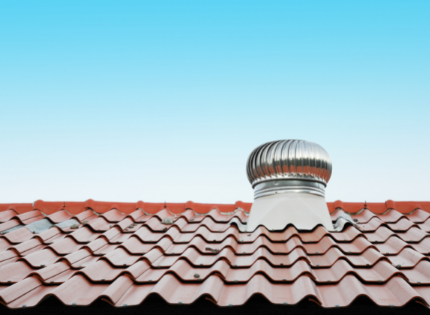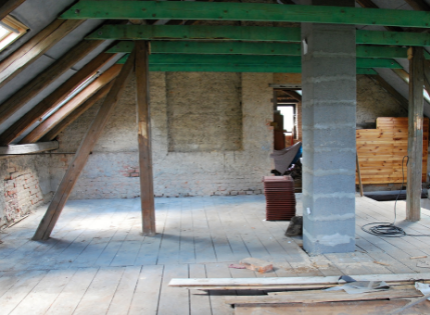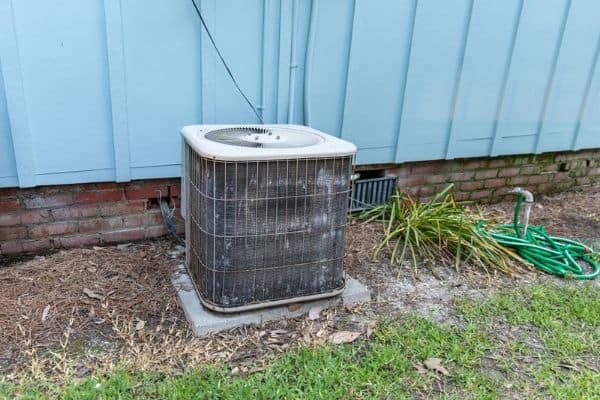Contents (Click To Jump)
How Does An Attic Fan Work?
Attic fans are ventilation devices that help cool down their home in the scorching summer months. Some homeowners use attic fans as an energy-efficient alternative to an air conditioning system.
However, attic fans don’t actively cool the air in your home; they circulate in new air from the outdoors. They remove the stagnant, warm air in your home and replace it with cooler air from the outdoors.
Attic fans go into a hole in your attic floor that opens to the ceiling of the top floor of your home. It pulls air through your home’s bottom levels and into the attic, where it exhausts through the soffits, eaves, gable vents, a window, or other exterior vents in your attic space. It is an easy and effective method of removing heat from homes.
What Are The Different Types of Attic Fan Ventilations?
Not every attic fan is the same. In fact, looking up attic fans can get confusing. Some places refer to attic fans as a fan that strictly vents your attic, while others refer to whole-house fans as attic fans. While both are fans that go into your attic,there are certain distinctions between different types of attic fans.
Here’s how they compare.
Standard Whole-House Attic Fans
A whole-house attic fan gets mounted into the ceiling of your home’s top floor (or the attic’s floor, depending on how you look at it). It sucks air from the livable space in your home and into the attic, where it exhausts through the soffits, gables, windows, or even an exhaust attic fan.
Whole-house fans remove heat by moving air in your home out. It creates negative pressure in your home. If you leave the windows of your home open, the whole-house attic fan will pull in cooler air from the outside.
Whole-house attic fans work best in a central location on the home’s top floor, like in the ceiling of a hallway or common area.
Exhaust Attic Fans
Powered attic exhaust fans or attic ventilators operate on electricity and pull air out of your attic. They don’t remove air from the livable parts of your home through the attic like whole-house fans do.
Instead, they are installed in the roof or wall of the attic and vent air directly from the inside of the attic to the outdoors. They help lower the temperature of the rest of your home since they cool down the attic.
Since these types of exhaust fans connect the inside of your attic to the outdoors, they could become a point of ingress for vermin, bugs, or rain if they are improperly sealed.
Additionally, since attic vent fans run often, they usually have good energy efficiency, but they do still use electricity. However, you can mitigate this energy increase by using a solar-powered version.
Solar-Powered Exhaust Attic Fans
Solar-powered attic exhaust fans do precisely what their name implies. They exhaust air from your attic and are entirely powered by UV energy from the sun. Otherwise, they perform the same function as regular exhaust fans that draw power from an outlet in your home.
The distinct advantage that solar attic fans offer is that the energy they use is free. In comparison, all-powered units can use up a ton of electricity after constantly operating for months on end. Of course, a solar-powered unit costs more upfront, and it will take a few years before you make a return on your investment.
Solar-powered attic fans have the same potential downsides as their non-solar siblings (minus the energy usage). The solar panel that powers them could also get blocked from dust and leaves, or damaged from fallen branches. Since they are typically installed high up on your house or roof, they are troublesome to service and repair.
Roof Turbines
Roof turbines or whirlybird turbines use a mechanical blade cowl that rotates about a central axis. They connect to an exhaust pipe on the top of the roof and are entirely powered by wind.

Their design enables them to suck warm air out of the attic as they rotate. However, they need to be hit with at least five mph wind to be effective. Additionally, the airflow they produce is a low CFM.
Other Types of Attic Ventilation
Besides active venting with exhaust fans requiring a power source (solar, wind, or electricity) to operate, there are passive venting methods for attics too. These passive venting devices are not fans but rather static vents that air can freely flow through. You likely have vents in your attic already without even knowing it. They include:
- Gable vents
- Off-ridge vents
- Ridge vents
- Box vents
- Soffit vents
What Are The Benefits Of Attic Fans?
Attic fans have many benefits. They provide fresh air into your home, and they cool it. Using a whole-house attic fan can drastically lower your energy bills compared to using a central AC system. Plus, they don’t need ductwork. Here are the main benefits of whole-house attic fans.
Cooling
During the hot summer months, the sun is beating down directly on your roof. Combined with the heat rising from the lower levels of your home, your attic can reach over 150ºF. As such, that much heat lingering in your attic will keep your home extremely warm, especially if you have insufficient ventilation.
The purpose of attic fans is to eliminate the buildup and stagnation of the hot air in your attic space. Attic exhaust fans push the hot air inside the attic outdoors.
Whole-house attic fans provide an even better degree of cooling. While they don’t actively lower the air temperature, they do bring in cooler air from the outdoors.
Removes Condensation
Condensation in your attic is no good. It can cause moisture build-up that can rot the wood inside your attic in the winter months. Additionally, high humidity can deplete the effectiveness of the attic insulation.
Moisture damage can be costly to repair, especially if it goes too long without being noticed. A properly ventilated attic removes enough to keep it dry.
Reduces Energy Usage
Comparing the energy use of a whole-house attic fan compared to a central air conditioning system side-by-side makes it clear that an attic fan uses much less electricity. Therefore, you will save energy if you use a whole-house attic fan instead of central air conditioning.
However, an attic fan does not provide any cooling effects. It only brings new air into your home through open windows and shoots it into the attic.
Therefore, using a whole-house attic fan on a 100ºF day won’t do much to cool your home. However, on mild summer days, with outdoor temperatures of 70ºF to 85ºF, the inside of your home might be 10 to 15 degrees warmer without your AC running. In this case, a whole-house fan could lower the home’s temperature equivalent to the cool air outdoors.
What Are The Disadvantages Of Attic Fans?
Unfortunately, attic fans have their downsides and limitations. Electric fans need energy to run, which could add up. Additionally, equipment failures could lead to expensive home repairs, and whole-house fans might not provide adequate cooling and comfort. Plus, constantly bringing in fresh air isn’t always a good thing.
Here are the disadvantages of attic fans.
Potential for Leaks
Exhaust fans that go on the roof of homes to cool the attic can be subject to shoddy installation. For example, if a contractor installs them incorrectly, it could develop leaks and have improper sealing. If the seals are poor, the gap could be wide enough for insect infestation or even bats and other vermin.
Might Not Cool Enough
Whole-house attic fans remove the air from inside your home and expel it into the attic. At the same time, they bring in new air from the outdoors. If it is too hot outdoors, the attic fan loses functionality since it can’t lower the air temperature. You’ll need an air conditioner in this case.
Takes Up Floor Space
Whole-house attic fans mount directly into the attic floor, and they take up valuable floor space. Perhaps you use your attic for storage, and if you install a whole-house attic fan, you’ll have to find a new storage location for your holiday decorations and old newspaper.
Additionally, if you have a finished attic or plan to finish it in a home improvement project, a whole-house fan would entirely throw off the feng shui and inhibit space utilization.
Increases Humidity
For those that live in humid climate zones, like the southeast U.S. (i.e., Florida), you are no stranger to the hot and muggy conditions. Using a whole-house fan in humid conditions can cause excess moisture in your attic and ice damming on your roof in the winter. This can degrade the wood and the insulation in no time.
Hello Allergies
Whole-house attic fans bring a constant influx of outside air into your home. If you suffer from allergies or are sensitive to outdoor pollution, cooling your home with a whole-house fan could put you in a world of hurt.
When the whole-house attic fan increases the airflow through the open windows in your house, it will also suck in all the pollen and pollutants suspended in it. Thankfully, you can turn off your attic fan, close your windows, find your thermostat, and crank on the AC instead.
How Can You Prevent Hot Air From Getting Into Your House Through The Ceiling?
In the summer months, your attic temperature will surely rise. With the sun beating down on the roof along with the stagnant air, the attic temperature can get much higher than the outdoors.

Since the attic gets hot, its heat can easily spread to the rest of your home. Unless, of course, you do everything you can to prevent that. Here are the top strategies you can use to prevent your attic from overheating your home.
Insulation
Proper attic insulation can prevent it from becoming too hot in the first place. Additionally, insulation between your attic and the rest of your home can prevent heat transfer from the attic to the living space.
Insulation can range from blown-in and spray foam to fiberglass. Upgrading the insulation in your attic is one of the best ways to prevent your home from overheating.
Sealing
Air leakage between your attic and the rest of your home will allow the heat from the attic to flow more easily into the rest of your home. As such, you should inspect your attic for any potential air gaps and seal them with expanding foam. Proper air sealing prevents heat transfer, which will lead to a cooler home.
Shade
Unfortunately, if your home does not have a lot of natural shade, you cannot do much about it. When you step out into direct sunlight in the summer, you will feel much hotter than in the shade.
When sunlight hits your body directly, you get hit with not only UV but infrared light as well. Infrared radiation is responsible for making you warmer. This same principle also affects your home, making tree shade a valuable commodity in keeping your home cool.
You can strategically plant trees on the south side of your property to keep your home in the shade once they are fully grown. This solution takes years but can pay off 10 to 20 years down the road.
Heat Reflective Shingles
Unless you need new roofing, heat reflective shingles are not a cost-effective solution to preventing hot attic air from warming your home. However, if you are in the market for a roof replacement, look into asphalt shingles with heat reflective coatings or aluminum roofs with heat-reflective paint.
When Should You Get An Attic Ventilation Fan?
Homeowners should consider improvements in their attic ventilation if it overheats. An attic exhaust fan can help lower the attic’s temperature by removing the hot air, which will reduce cooling costs.
On the other hand, homeowners who want a more economical cooling method can opt for a whole-house attic fan and lower their utility bills. A whole-house attic fan is designed to be used when the home’s windows are open.
The fan sucks air in through the windows and pushes it into the attic, effectively cooling the home with cooler outdoor air. They don’t work the best on extremely hot days; homeowners mainly use them as a supplemental HVAC system on mild summer days.









